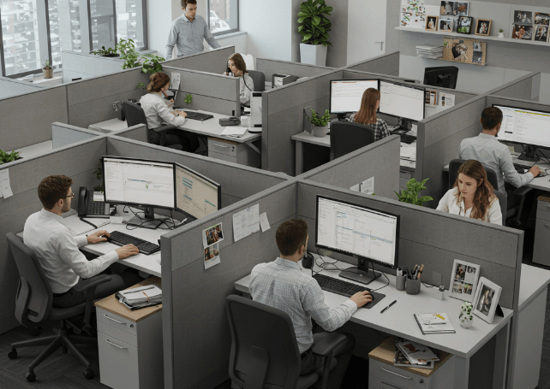
Office cubicle design plays a pivotal role in shaping employee experiences, influencing both efficiency and communication. As businesses strive to optimize productivity and foster effective teamwork, understanding how the physical layout of workspaces can impact these factors is crucial.
This article delves into the various aspects of cubicle design and its significant effects on employee efficiency and communication.
1. Spatial Layout and Accessibility
The arrangement of cubicles within an office can significantly affect employee interaction and workflow. An open layout with strategically placed cubicles encourages spontaneous collaboration and communication among team members.
When cubicles are designed with clear pathways and easy accessibility, employees can quickly engage with one another without the barriers of traditional office layouts. Conversely, poorly designed spaces can create obstacles that hinder movement, resulting in decreased efficiency and frustration.
2. Acoustic Considerations
Sound levels in a workplace can have a profound effect on concentration and productivity. In call centers or environments requiring high levels of focus, cubicle design should prioritize sound insulation. Incorporating acoustic panels and partitions helps minimize noise distractions, allowing employees to concentrate on their tasks.
When agents are not overwhelmed by background chatter, they can communicate more effectively with clients, resulting in higher-quality interactions and improved performance.
3. Privacy vs. Collaboration
Finding the right balance between privacy and collaboration is essential in cubicle design. While some employees thrive in open, collaborative spaces, others may require more privacy to perform their best work.
Designing cubicles with flexible configurations, such as semi-enclosed spaces or adjustable partitions, accommodates personal preferences. This flexibility boosts employee morale and enhances overall productivity by catering to diverse working styles.
4. Ergonomics and Comfort
The physical comfort of employees directly impacts their efficiency. Ergonomically designed cubicles that include adjustable desks, supportive chairs, and well-positioned monitors can reduce physical strain and fatigue. When employees are comfortable, they are less likely to take frequent breaks and more likely to stay focused on their work.
Furthermore, an emphasis on ergonomic design demonstrates that an organization values its employees' well-being, leading to increased loyalty and job satisfaction.
5. Technology Integration
In a tech-driven work environment, integrating technology into cubicle design is vital. Adequate power outlets, cable management systems, and easily accessible devices enhance functionality and reduce clutter.
When employees can efficiently access the tools they need, it promotes smoother communication, as they can collaborate using digital platforms without unnecessary interruptions. Seamless technology integration fosters a more productive workspace, empowering employees to perform at their best.
6. Natural Elements and Lighting
The inclusion of natural elements and adequate lighting in cubicle design can significantly impact employee mood and efficiency. Studies have shown that access to natural light improves focus and reduces stress levels.
Cubicles designed with large windows or those positioned near natural light sources can create a more inviting atmosphere. Incorporating biophilic design elements, such as indoor plants, can enhance well-being and promote a sense of tranquillity, leading to increased efficiency.
7. Promoting Team Communication
Effective communication is the backbone of any successful organization. Cubicle designs that facilitate informal interactions, such as lounges or communal areas, encourage teamwork and the sharing of ideas.
Employees who feel comfortable engaging with their peers are more likely to collaborate on projects and share valuable insights. Designing spaces that foster both formal and informal communication can lead to innovative solutions and a stronger sense of community within the workplace.
Conclusion
The impact of cubicle design on employee efficiency and communication is profound. Organizations can create workspaces that promote productivity and collaboration by considering factors such as spatial layout, acoustics, privacy, ergonomics, technology integration, natural elements, and team communication.
As the workplace continues to evolve, investing in thoughtful cubicle design will be essential for fostering an environment where employees can thrive, communicate effectively, and contribute to the organisation's overall success.